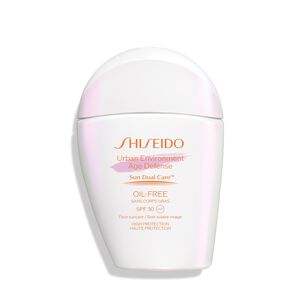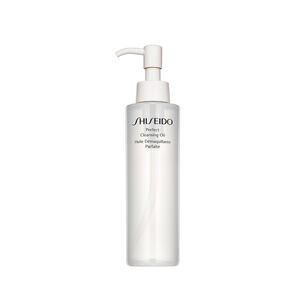
If you’ve been wondering ‘what actually is a blemish?’, you’ve come to the right place. It’s a word that’s used a lot in the skincare world, but it covers so many different marks that it can get confusing. So, keep scrolling to discover what blemishes truly are, the different types to be aware of, and how you can prevent new breakouts from cropping up. Your clearest skin awaits…
So, what are blemishes?
Notice an ‘imperfection’ on your skin? That is a blemish. It could be a small spot, a patch of hyperpigmentation or an acne breakout – they all count as blemishes. However, the word itself is most commonly used to describe a pimple (or pimples), so when you read tips on how to get rid of blemishes, the focus will usually be on spots.
Many of us get them at some point in our lives, and they’re nothing to be ashamed of. In fact, it’s rare anyone notices your own breakouts but you, so don’t let them get you down. Instead of panicking and reaching for the nearest scrub or spot treatment to dry blemishes out, get to know the types of spots and their causes better – then you can find a soothing routine that works just for you.
6 types of skin blemishes to know
Not every blemish is the same. From small, easy-to-soothe whiteheads to large, painful cysts - spots appear in all different shapes and sizes. Here’s how to figure out what type of blemish you’re dealing with…
Whiteheads
One of the mildest types of blemish, a whitehead appears as a flesh-coloured bump that can easily be popped (but don’t). Usually, these small spots are caused by a build-up of sebum that clogs your pores.
Blackheads
Blackheads are exactly what they sound like: tiny black blemishes on the skin, which are caused by clogged hair follicles. You’ll typically find them through the t-zone – the area that covers your nose and forehead – on oily complexions.
Papules
These are small but hard red spots that don’t have a head, meaning you can’t see any pus. The blemish is a solid and inflamed bump that may transform into a pustule before it fully heals.
Pustules
Like a whitehead, a pustule tends to appear as a white or yellow, pus-filled spot. However, it’s angrier and more inflamed, often surrounded by reddened skin and swelling that may feel tender.
Cysts
Cysts look similar to boils, appearing as large, rounded spots that can often be painful. Because of how deeply rooted they are in your skin, they also leave you at risk of scarring. So, while it might be tempting to squeeze them, it’s important you keep your hands away and let them gradually heal with a soothing skincare routine.
Nodules
These tend to be the largest, deepest and most stubborn type of blemish. They look like a cyst, but they feel much harder and can be even more painful. Again, nodules can leave a scar if you squeeze them or touch them too much, which means it’s extra important to leave them alone and let your skincare do the work.
What causes blemishes on your face?
Clogged pores
For All Skin Types: Deep Cleansing Foam
One of the most common causes of blemishes is clogged pores. If you have naturally oily skin, excess sebum can become trapped and turn into a blemish that becomes tricky to remove. But that doesn’t mean dry complexions are safe. In fact, if your skin becomes too dehydrated, your sebaceous glands start pumping out even more sebum which causes clogging too. The answer is keeping skin clean, balanced and hydrated from day to day. That means washing your face morning and night (try the Deep Cleansing Foam) and following up with a quenching moisturiser, like Benefiance Wrinkle Smoothing Day Emulsion.
Damaged skin barrier
What is the skin barrier, you ask? It's the outermost layer of your skin, which works like a built-in security system to keep infections out and allow nutrients in. Whether due to extreme weather, too-harsh skincare products or a hormonal imbalance, this barrier can become compromised – and when it does, your pores can’t fend off breakouts as effectively. Look for the signs of skin barrier damage to figure out if this could be the problem. These include persistent dryness, chronic skin infections, itchiness, redness and delayed wound healing.
Imbalanced diet
If you’re not getting enough of the vitamins and minerals your body needs to stay healthy, it can start to show up on your skin. Maintaining a balanced diet is key to a healthier complexion from the inside out. So, try to make sure you’re eating foods rich in vitamins A and E and zinc, as well as drinking at least two litres of water per day to top up hydration levels.
Hormones
Your hormones play a big role in the condition of your skin. Case in point: dry menopausal skin happens when levels of a hormone called oestrogen diminish, as it means your pores produce less collagen. So, it’s no surprise that changing hormones can also affect breakouts and blemishes. If you suspect this might be at the root of your acne, talk to your doctor.
UV damage
For All Skin Types: Urban Environment Age Defense Oil-Free SPF 30
Along with wrinkles and dark spots, blemishes are just one of the many side effects of UV damage. If your skin is getting too much sun, those harmful rays may throw your sebaceous glands off balance, causing spots to appear. That’s why it’s extra important to apply and reapply a high protection sunscreen every day. Choose an oil-free formula that won’t clog your pores and feels light on skin, like Urban Environment Age Defense Oil-Free SPF 30.
Stress and lack of sleep
When you’re stressed and sleep-deprived, your body can’t function at its best. Even your complexion suffers, as your skin needs a full night of sleep in order to repair cells. Worse still, your immune system struggles to fight off infections during times of stress, which means you’re not only vulnerable to blemish-causing bacteria, but to viruses as well.
How to prevent blemishes
1. Maintain an effective skincare routine
Consistency is key when it comes to a blemish-fighting skincare routine. While we want spots to vanish overnight, it takes time, patience and using the right products every day to reach a clearer complexion. So, just because a formula doesn’t work instantly doesn’t mean you should move on to something else. In fact, switching up your products too often may actually aggravate a breakout even more. Try to give a new routine at least 30 days to see results, then assess the condition of your skin at the end to figure out what’s working (and what is not).
2. Remove makeup every night
For All Skin Types: Perfect Cleansing Oil
If there’s one skincare rule you should stick to daily, it’s removing your makeup every. single. night. Tucking yourself up in bed with foundation or concealer still on is a recipe for clogged pores and more blemishes. Make double cleansing part of your night-time routine to really rid your complexion of spot-causing bacteria. First, use the Perfect Cleansing Oil to sweep away makeup and surface grime, then follow with the Deep Cleansing Foam to wash out deep-down dirt and impurities.
3. Keep your skin hydrated
Your skin needs the right balance of purity and moisture to keep sebum levels on track, so always follow your cleanser with a skin softener and moisturiser to quench your pores. Hydrate from the inside, too, by drinking water all throughout the day. Keep a water bottle with you, so you never forget to sip whenever you’re feeling thirsty.
4. Shampoo your hair regularly
Because your hair is so close to your face, any oil in your scalp can easily affect the rest of your skin – especially if you have a fringe or face-framing layers. So, make sure you’re shampooing regularly to keep sebum at bay. If your skin is sensitive, use a sulphate-free shampoo or cleansing conditioner, which gently purifies your scalp and your hair.
5. Don’t touch your skin
Unless you’re massaging in moisturiser or applying sunscreen, try not to touch your skin, as this will spread more bacteria to your face. The same goes for squeezing spots – let your skincare take care of them instead. Otherwise, you can force the infection deeper into pores, which will slow down healing and make scarring more likely.
6. Address stress levels
It’s often easier said than done, but try to reduce stress. Most importantly, it’s better for your mental health, but has the side effect of being better for your skin as well. That might mean saying ‘no’ to too many diary dates, embracing serotonin-boosting exercise, or catching up and venting with a friend. Whatever ‘less stress’ means to you, make it a regular priority.
FAQs about blemishes
1. What’s the difference between acne and blemishes?
Acne is a skin condition, while blemishes are a symptom of that condition. So, in some ways they’re the same, and in other ways they’re completely different. It’s important to remember that having one or two blemishes doesn’t always mean you’re suffering with acne; it’s only when those spots are widespread and persistent that you might be dealing with acne-prone skin.
2. Will blemishes go away?
Yes, your blemishes will go away. Over time, and with the right products, your skin will begin to heal, although the timespan can vary from one spot to the next. Some could be gone in a matter of days while others can last for one month or more. Meanwhile, if scars are left behind, these could take anywhere from three months to one year to fade.
3. How long does a skin blemish last?
For All Skin Types: Vital Perfection LiftDefine Radiance Serum
There’s no ‘one size fits all’ answer, but how long a blemish lasts usually depends on how inflamed it is. If it’s a small whitehead, consistent skincare may see it vanish in less than one week, while if it’s a larger cyst, it can take a few weeks to shrink down. In some cases, you may be left with a small, flat mark after the spot has cleared. Using a brightening serum, like Vital Perfection LiftDefine Radiance Serum, will help it to fade over time.
4. When should I worry about skin blemishes?
If a spot doesn’t heal within four weeks, and starts to grow, hurt, scab over, feel itchy or bleed, see your doctor to rule out any underlying medical causes.
5. What skin type is prone to blemishes?
Blemishes can happen to anyone at any time, but oily skin types and very dry skin types are more likely to experience breakouts due to imbalanced sebum glands. It’s not just a teenage bugbear; in your twenties, thirties and even during menopause, spots can appear. That’s why taking good care of your skin with regular cleansing and moisturising is vital at every stage in life.
6. Can stress cause blemishes?
While stress itself won’t directly cause acne, research suggests that if you already suffer with regular breakouts, being run-down can make the problem worse. Plus, when you’re stressed, you’re less likely to be getting the restful sleep your body needs, so your skin can’t go into ‘overnight repair’ mode; the healing process that keeps your skin cells healthy.
Up next: Now you know about the many different types of blemishes and what causes them, discover how to get rid of blemishes with our complete guide.The information in this post is for educational purposes only, and does not substitute for professional medical advice. Readers are advised to consult a medical professional or healthcare provider if seeking medical advice, diagnoses, or treatment.





